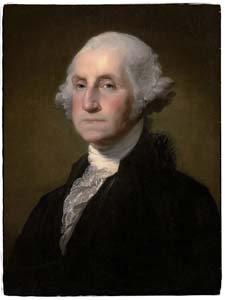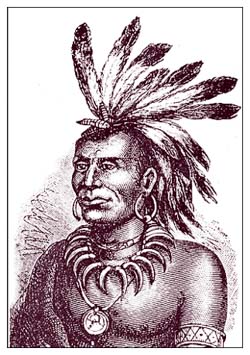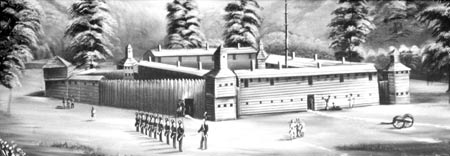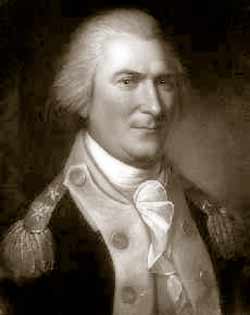- Ohio History in 2000 Words
- Mound Builders
- Native Ohioans
- The Ohio Company
- Ohio's Wood Forts
- Indian Wars
- War of 1812
- Ohio's Canals
- Ohio's Road
- Scenic Railroads / Museums
- Underground Railroad
- Civil War in Ohio

The newly formed federal government under leadership of President George Washington and Secretary of War Henry Knox, believed hostile attacks on the western frontier were the result of a few rebellious leaders. In part they were correct. What they failed to see were the numbers of warriors willing to follow these leaders.

These indigenous leaders were fighting for their land, a way of life and their widespread families that inhabited this land for the last 200 years. For the last 75 years these indigenous families had tried to deal with the Europeans that had begun to infiltrate their home land. Even agreed to documents that promised this would not happen, did not stop the increasing waves of settlers, that were often hostile, that often led to the massacre of their family villages. The indigenous leaders had grown weary of the promises. They had made conscious effort to wage a guerrilla war against the settlers. When the opportunity presented itself, the Native Americans would attack frontier settlements, butchering the family, burning their cabin, taking their livestock, taking their children.
By 1790 there was a concerted effort by two major Ohio Country groups, the Miami and the Shawnee. The Shawnee were being led by Blue Jacket and the Miami by Chief Little Turtle. These two leaders not only united their respective families, but they also joined forces. In so doing they also attracted other Ohio Country families including the Wyandot and Delaware.
This was the environment that Chief Little Turtle had grown up in. It was his decision to unite the various Native American families to protect their families and villages against the European now American forces and their armies.
The first major army was led by General Josiah Harmar. The task given to him by Secretary of War Knox, was assemble an army, build a fortification at a suitable spot on the northern side of the Ohio River, march that army north, find and destroy Little Turtle's village and kill Chief Little Turtle.

Fort Washington as seen from Ohio River
It was also facing a battle tested Miami Chief named Little Turtle who was well acquainted with European military tactics now being used by the Americans. To complicate Harmar's expedition even more, he was leading a group made up of militia who were notoriously known for their lack of discipline.
Little Turtle, who had scouts shadowing Harmar almost from the time he left Fort Washington, probably had a better awareness of Harmar's forces that the general. Progress was painfully slow through the thickly wooded hills of southwest Ohio. Harmar had decided he would build a road could handle supply wagons coming from Fort Washington.
When all combined Harmar's expedition had 320 regulars and 1,133 militia.
As Harmar's expedition moved north with the goal of attacking a major Miami village at the confluence of the St. Joseph and St. Mary's Rivers, it began running into problems as a result of poorly trained militia. Little Turtle easily divided Harmar's forces, leading them into one trap after another, reducing his fighting force with , fighting on ground that Little Turtle had wanted and prepared.
Harmar had to retreat and his expedition was a complete failure. Secretary of War Knox realized that Harmar was just not the right man for the job, and that his plan of removing the renegade problem could still work; all it needed was a new and better leader. President Washington recommended his former aid-de-camp, Arthur St. Clair.

His Miami name was Mishikinakwa, but the English called him Little Turtle. Mishikinakwa was born in 1752 in a village close to where Fort Wayne would later be built. His mother was a Mahican and his father a Miami Chief.
Knowing that after such a devastating defeat against General Harmar, Little Turtle urged his compatriots to be prepared for a second military engagement. He knew that like the Englishmen, the Americans would not let their defeat go unchallenged. Preparation for the second invasion had been ongoing. Scouts had reported St. Clair's movement since it left Fort Washington. On November 3, seeing them make their way to the east bank of the Wabash River, Little Turtle saw an opportunity. He couldn't believe his good fortunes.
The great general failed to set up his camp for the night in a strong defensive position as he had since leaving Fort Washington. The well-trained military were all located in the center of a large circular encampment, defended by poorly trained militia. The general's artillery pieces were also mounted on the high ground where they couldn't be used to any advantage.
This was the opportunity he was looking for and the attack would be before dawn.

When Arthur St. Clair, then governor of the Northwest Territory, was requested to lead a second expedition into the Ohio Country and finish the task assigned to General Josiah Harmar, it was not just a political appointment. Years before he had been an experienced soldier, had fought in the French and Indian Wars, and later took up arms against the British during the Revolutionary War.
During the Revolutionary War Arthur St. Clair rose to the rank of Major General and as a commander St. Clair was not without some controversy.
Early in the war St. Clair was ordered to defend Fort Ticonderoga from British attack. When presented with overwhelming forces, St. Clair was forced to withdraw and surrender his position to the British. A year later he was brought before a court-martial to face a charge of cowardice.
During St. Clair's court-martial, the facts of Fort Ticonderoga were presented and Arthur St. Clair was acquitted. Yet despite his acquittal he was nonetheless removed from field command and became an aide to General George Washington, who seemed to have developed an appreciation for St. Clair's abilities which appear to be well suited to organization and as Washington would later find, does not necessarily translate to field command.
What Josiah Harmar had failed to do, Northwest Territorial Governor Arthur St. Clair was now expected to accomplish. Unfortunately for St. Clair, all of the factors that led to Harmar's defeat were still in place.
Starting out from Fort Washington along the Ohio River, General St. Clair had several forts built including Fort Jefferson which was about 30 miles south of where St. Clair decided to stop on the eastern shore of the Wabash River. When they arrived at this point, the troops were exhausted and it was St. Clair's belief that the hostiles were still several days journey west. He would later claim that was the reason for not erecting any defensive works on the afternoon of November 3. A cold front had dropped down from the north and it looked like snow. It had been 2 months since St. Clair's men had left the comforts of Fort Washington, trekking through the wilderness and now a cold winter was beginning to be felt.
At this point in the expedition St. Clair had about 1300 men under his command. There were also 30 or so women that came along with their husbands. They helped prepare food, kept the men company, and repaired clothing as needed. A slightly elevated position was selected for the main encampment. This included most of the regular army, artillery pieces and the women. Two parallel lines of tents were set here with several artillery deployments facing east and west were also set up.
Across the river on the west side a detachment of militia formed the western flank. An eastern flank was also deployed along with several smaller camps just to the south and one to the north.
Unknown to St. Clair was the fact that Little Turtle and about 1500 braves were just a mile northwest of their encampment. They had already begun their ritual fast for their planned early morning attack.
The night before, the men were exhausted and disgruntled. Some of Major General St. Clair's men, especially the militia were grumbling amongst themselves as they settled in around their warming camp fires for the night, complaining that their 54 year old general may not be the right person to lead them. Most didn't know that their commander had earlier become ill.
It was early morning, a few stars could still be seen pinpointing the morning sky. During the night a light snow had fallen across the camp giving a slightly muffled sound when the first shots were fired. A group of 30 Native Americans had attacked the Kentucky militia positioned on the west side of the Wabash River. Meanwhile the main Native America force had broken into two forces: one taking to the north side of the main camp and the other to the south.
When those first shots sounded, St. Clair roused from his sleep and quickly began barking orders. The attack, which St. Clair had just become aware was three pronged. The middle, which is where those first shots were fired was the center prong. The two much larger flanks and which would soon be firing into the center of St. Clair's main camp, were on the north and south sides of the encampment.
The initial center attack from the west was accomplished with a only about 30 warriors. With little warning and no preparation the Kentucky militia protecting the western flank were thrown into complete disarray. They had become so rattled that they ran from their position across the Wabash right into the middle of St. Clair's main force, along with the Miami, Shawnee and Delaware running right beside them into the midst of the main camp using knives and tomahawks. The camp was complete disorder and confusion.
Some of the artillery pieces were loaded and fired, but without effect. The thick smoke filled the forest making it even more difficult for the soldiers to find already allusive targets.
At just about this time, the two flanking forces had begun attacks on the outer perimeter encampments. On the north side Mingo, Wyandots and Cherokees began their assault. The south was being assaulted by Ottawa, Ojibwa and Potawatomi. Artillery pieces that had been set up the evening before were unable to locate any targets, but they did fire blindly into the woods surrounding the camps, but they couldn't lower their elevation enough to have any effect. However, the canon fire did create a screen of sorts allowing the enemy to quickly infiltrate all of the artillery positions and permanently silenced the gun crews.
By 8:30 that morning, St. Clair had regained command of what remained of his force. Entire companies that were bedded down the night before were completely gone. For a few moments a quiet lull crept across the battlefield as the Native American commanders met to assess their situation. The council of leaders finally decided it was time to rejoin the fight. What they found upon their return was that the American forces had completely fallen into disarray. St. Clair had abandoned his southern camp, moved what men he could to the north. Here he had the artillery pieces spiked and began evacuating the wounded from the south.
At this point the entire command was surrounded. The time was now 9:30 a.m., about 3 hours after the battle had begun. Half of St. Clair's men were dead and all hope had been lost. St. Clair made a quick decision on how to get those still alive and able to move to a safer position was hastily ordered. It was frantic and unorganized, but St. Clair was able to save about a third of his command. The pursuing attackers most likely felt it would be unwise to follow them any further back to Fort Jefferson and instead returned to the main battle site. The fleeing army dropped all of their non-essential items along the trail and began moving south as quickly as possible.
Fort Jefferson was 29 miles south of the battle and it was well after sunset before the first of St. Clair's survivors began arriving at Fort Jefferson, but they were soon disappointed. Fort Jefferson was completely out of supplies, but were expecting a supply convoy to arrive at any time from Fort Hamilton. After waiting for the rest of the survivors to arrive and rest a bit, they set out yet that evening. Early on the afternoon of the following day, they made contact with the supply convoy.
Once St. Clair and his men returned to Fort Washington he sent a packet to President Washington and Secretary of War Henry Knox detailing the defeat. Congress demanded an investigation. The president demanded St. Clair's resignation.
The investigation found mismanagement by contractors and the Quartermaster. Lack of discipline and experience were also factors. President Washington wanted St. Clair's resignation, but he continued as Governor of the Northwest Territory until 1802.
During the Battle of the Wabash General St. Clair lost about two thirds of his command and had two horses shot out from under him. Back at Fort Jefferson someone pointed out to the general that his frock had multiple bullet holes and a big slice of his hair had been sheared off from a near miss.
A congressional investigation resulted in the formation of a new army (The Legion of the United States). It would be better trained, better supplied, with a proven leader commanding the men: Major General Anthony Wayne. His first assignment finish what St. Clair had failed to do.
If Wayne could accomplish this task, the federal government would be able to sell valuable land in the Ohio Country and with those funds run the federal government for a few more years until congress could figure a more permanent means of funding the government.